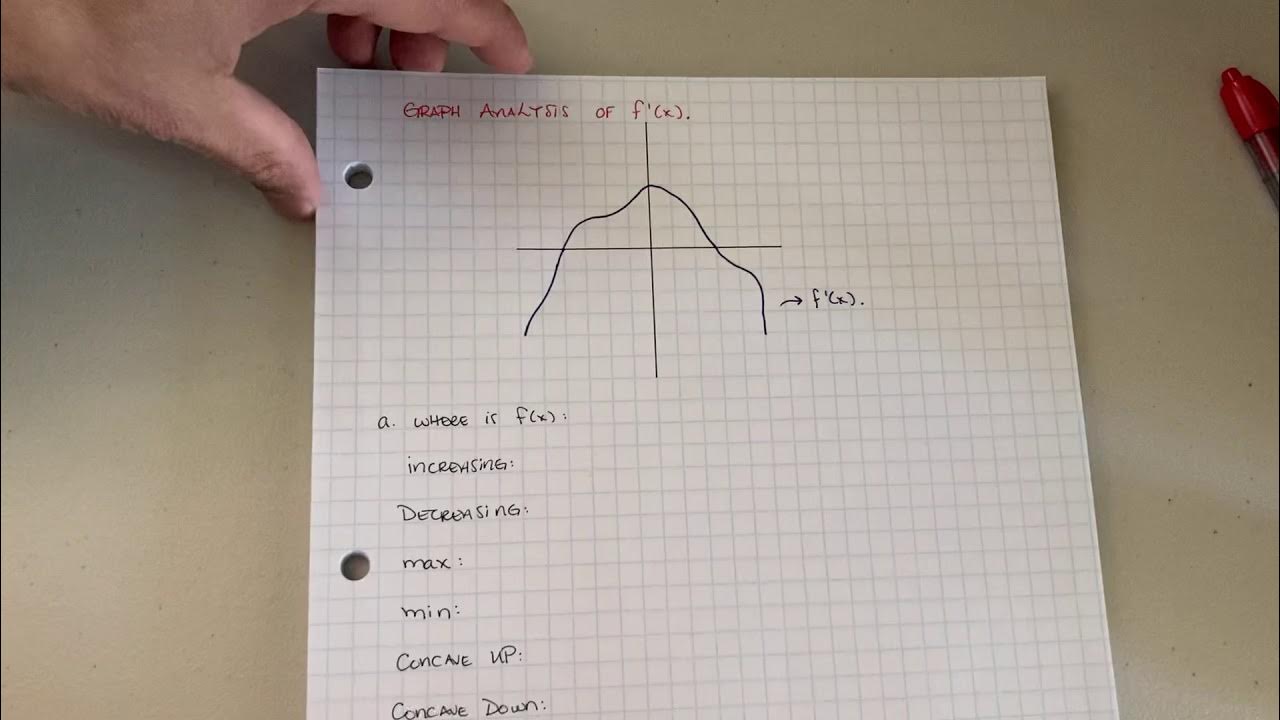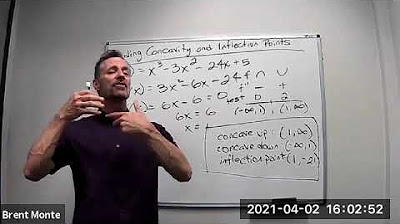Graphing with Calculus
TLDRThe video script presents a mathematical problem-solving session focused on graphing a function based on its derivatives without the explicit function given. The presenter uses provided points and intervals for the first and second derivatives to deduce the function's behavior and inflection points. It is established that the function is monotonically decreasing up to x=3 and increasing from x=3 to x=6. The second derivative analysis reveals the function is concave up from x=0 to x=5 and concave down from x=5 to x=6, suggesting an inflection point at x=5. Additionally, a bonus problem confirms that quadratic functions, defined as ax^2 + bx + c with a ≠ 0, have no inflection points since their second derivative, 2a, never equals zero.
Takeaways
- 📈 The problem involves graphing a function without knowing its explicit form, using provided properties of its derivatives.
- 🔢 The function's value at x=0 is 3, at x=3 is 0, and at x=6 is 4, providing key points for the graph.
- 📉 The first derivative of the function is less than 0 on the interval (0, 3), indicating the function is decreasing on that interval.
- 📈 The first derivative is greater than 0 on the interval (3, 6), suggesting the function is increasing on that interval.
- 🎢 The function's derivative is suspected to be 0 at x=3, due to the change in monotonicity.
- 📊 The second derivative is greater than 0 on the interval (0, 5), implying the function is concave up on this interval.
- 📉 The second derivative is less than 0 on the interval (5, 6), indicating the function is concave down on this interval.
- 🔄 The point x=5 is hypothesized to be an inflection point, where the function changes from concave up to concave down.
- 📝 Assumptions were made about the function's continuity and differentiability over the intervals, as these were not explicitly stated.
- 🔍 The problem demonstrates the use of derivatives to infer a function's behavior without knowing its exact form.
- 🏆 A bonus problem is solved, proving that a quadratic function (ax^2 + bx + c) has no inflection points because its second derivative (2a) is never 0.
Q & A
What is the main problem discussed in the video script?
-The main problem discussed is graphing a function based on the properties of its first and second derivatives without being given the explicit function.
What are the given points from the script?
-The given points are f(0) = 3, which is the point (0,3), f(3) = 0, and f(6) = 4, which is the point (6,4).
What can be inferred about the first derivative of the function from the information provided?
-The first derivative is less than 0 on the open interval (0,3) and greater than 0 on the open interval (3,6), suggesting the function is decreasing before x=3 and increasing after x=3.
What is the role of the first derivative at x=3?
-The first derivative is suspected to be 0 at x=3 due to the function changing from decreasing to increasing, though this is an assumption based on the function's behavior around this point.
How does the second derivative information help in understanding the graph's concavity?
-The second derivative being greater than 0 on the interval (0,5) indicates the function is concave up, and less than 0 on the interval (5,6) indicates the function is concave down, revealing changes in the curve's shape.
What is the significance of the inflection point between x=5 and x=6?
-The inflection point between x=5 and x=6 is significant because it's where the function changes from concave up to concave down, indicating a change in the curve's concavity.
Why is it assumed that the function is continuous and differentiable over all intervals?
-This assumption is made because the script does not provide any information to the contrary, and typically, functions are assumed to be continuous and differentiable unless specified otherwise.
What is the bonus problem discussed at the end of the script?
-The bonus problem is to prove that a quadratic function, defined as f(x) = ax^2 + bx + c, has no inflection points.
How is it proven that a quadratic function has no inflection points?
-The second derivative of a quadratic function is 2a, which cannot be 0 unless 'a' is 0. However, if 'a' is 0, the function is not quadratic but linear, hence a quadratic function can never have an inflection point.
What is the main takeaway from the video script regarding first and second derivatives?
-The main takeaway is that first and second derivatives provide valuable insights into a function's behavior, including its monotonicity and concavity, even without knowing the explicit form of the function.
How does the video script demonstrate the use of derivatives in function analysis?
-The video script demonstrates the use of derivatives by analyzing the given function's behavior through its first and second derivatives, allowing for the construction of a graph and understanding of its properties without the original function's formula.
Outlines
📈 Graphing a Function from Derivatives
This paragraph discusses a problem where the goal is to graph a function based on properties of its first and second derivatives, without being given the explicit function. The problem provides specific points and intervals where the function takes certain values, and the signs of the first and second derivatives. The speaker uses this information to deduce the shape of the graph, including a potential minimum point at x=3 where the first derivative is zero, and inflection points based on the concavity provided by the second derivative. The speaker also makes assumptions about the continuity and differentiability of the function, which are necessary to complete the graph.
📊 Inflection Points and Quadratic Functions
In this paragraph, the speaker focuses on the concept of inflection points and applies it to quadratic functions. An inflection point is defined as a point where the second derivative equals zero. The speaker explains that the general form of a quadratic function is f(x) = ax^2 + bx + c, and its first derivative is 2ax + b, while the second derivative is a constant 2a. Since a quadratic function is defined by a non-zero 'a', the second derivative (2a) can never be zero, meaning quadratic functions do not have inflection points. The speaker concludes by stating that this proves that quadratic functions lack points of inflection.
Mindmap
Keywords
💡Derivatives
💡Second Derivative
💡Inflection Point
💡Concavity
💡Continuous and Differentiable
💡Monotonicity
💡Quadratic Function
💡Minimum Point
💡Slope
💡Graph
💡Assumptions
Highlights
The problem involves graphing a function without knowing the explicit function, relying only on properties of its derivatives.
The function f(x) is given with specific values: f(0) = 3, f(3) = 0, and f(6) = 4.
The first derivative of the function is less than 0 on the interval (0, 3), indicating a decrease in the function's value.
The first derivative is greater than 0 on the interval (3, 6), suggesting an increase in the function's value.
The derivative is assumed to be 0 at x = 3 due to the change in monotonicity.
The second derivative is greater than 0 on the interval (0, 5), implying the function is concave up.
The second derivative is less than 0 on the interval (5, 6), indicating the function is concave down.
An inflection point is suspected at x = 5, where the concavity changes from up to down.
The problem assumes the function is continuous and differentiable over the intervals, despite not being explicitly stated.
The graph is expected to be in the first quadrant with the given points (0, 3), (3, 0), and (6, 4).
The function's graph is monotonically decreasing from (0, 3) and monotonically increasing from (3, 6).
The problem emphasizes the importance of understanding the relationship between derivatives and the original function without relying on calculators.
The bonus problem involves proving that a quadratic function has no inflection points.
A quadratic function is defined as f(x) = ax^2 + bx + c, where 'a' is non-zero.
The second derivative of a quadratic function is always 2a, which cannot be zero if 'a' is non-zero.
Since the second derivative of a quadratic function cannot be zero, it has no inflection points.
Transcripts
Browse More Related Video

Points of inflection from the graphs of f, f' or f''

Calculus I: Finding Intervals of Concavity and Inflection point

Point of Inflection - Point of Inflexion - f''(x)=0 - Definition - How to Find - Worked Example 1

Inflection Point Grade 12

AP Calculus AB: Analyzing the Graph of the first Derivative

Finding Concavity and Inflection Points
5.0 / 5 (0 votes)
Thanks for rating: